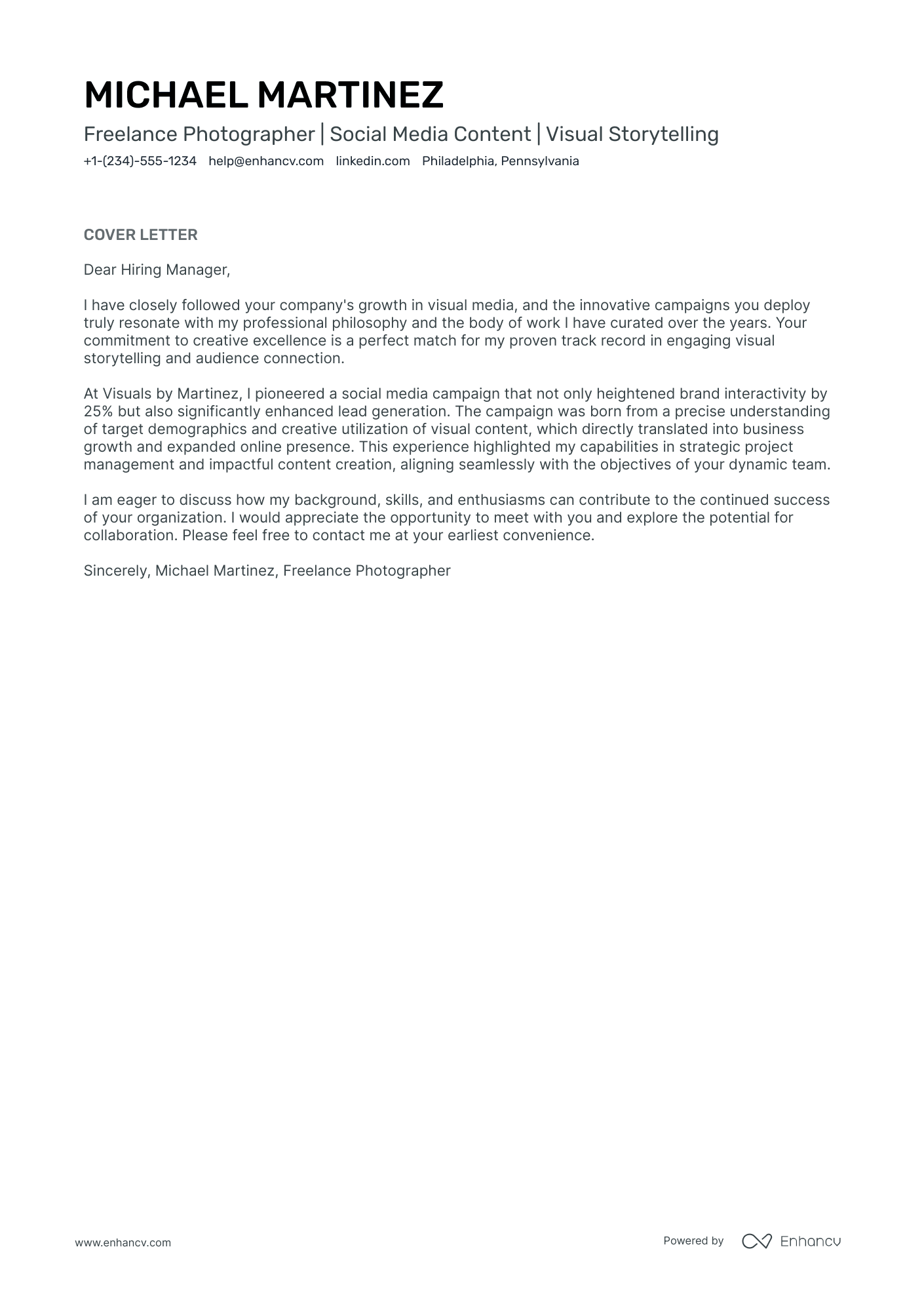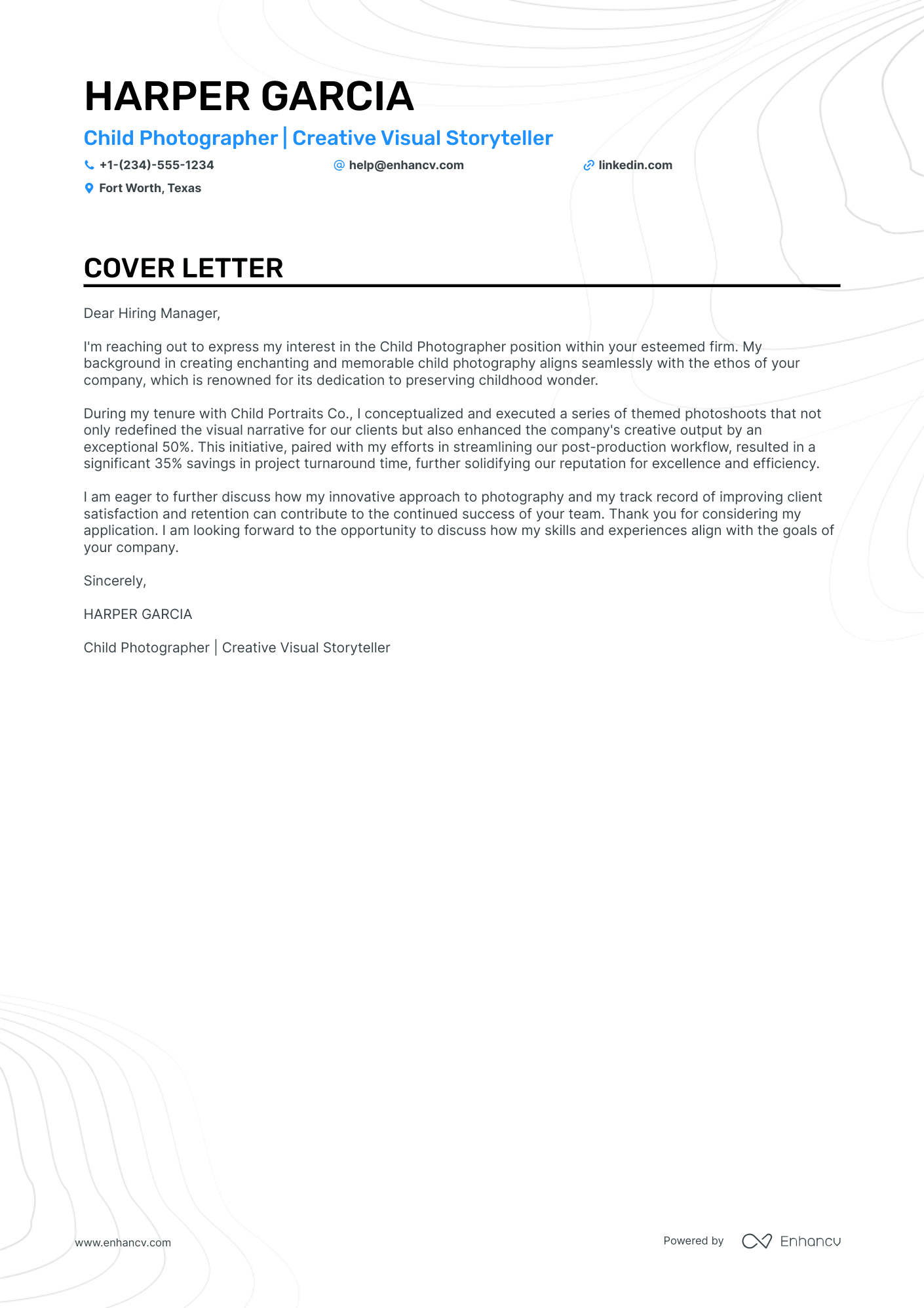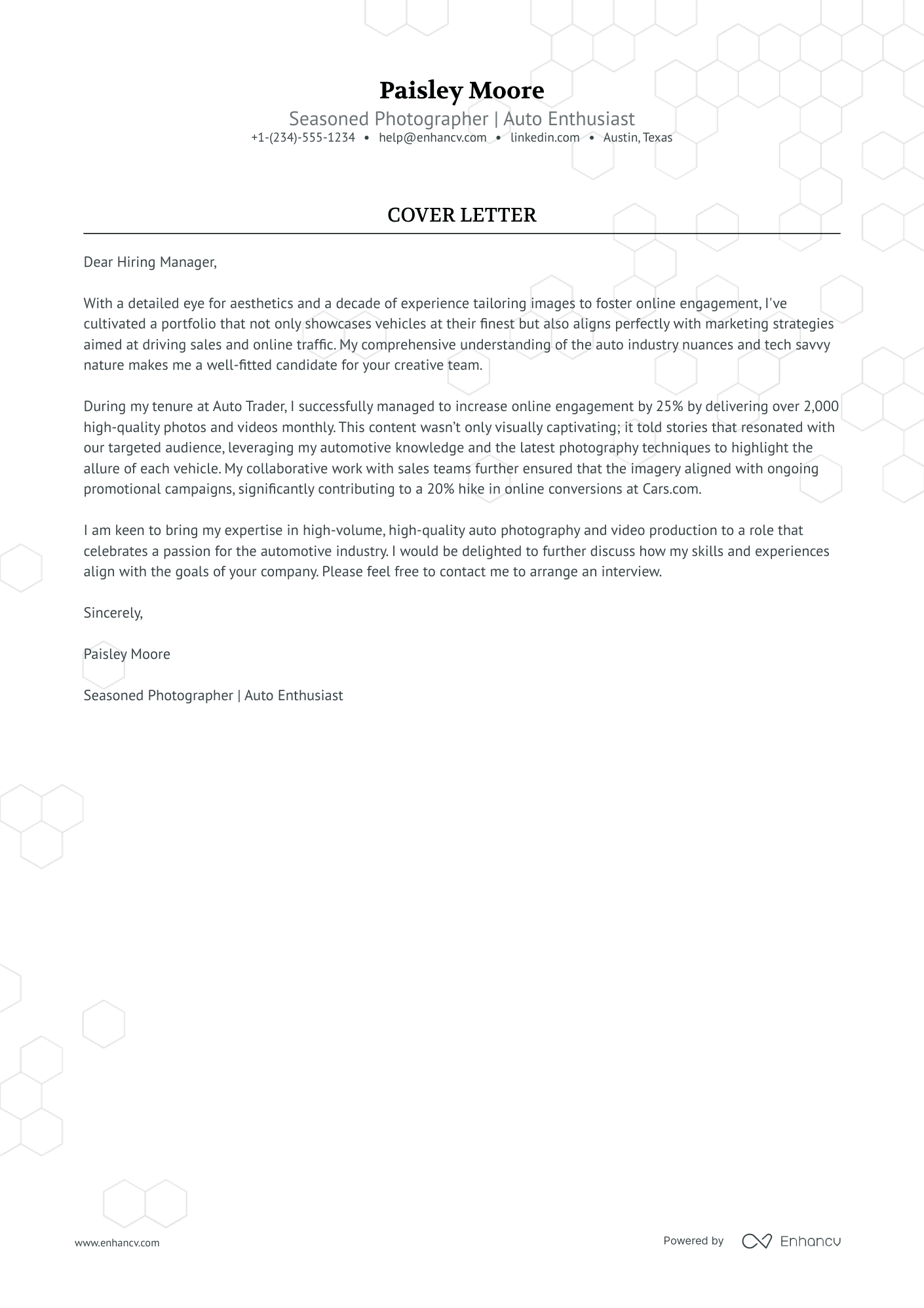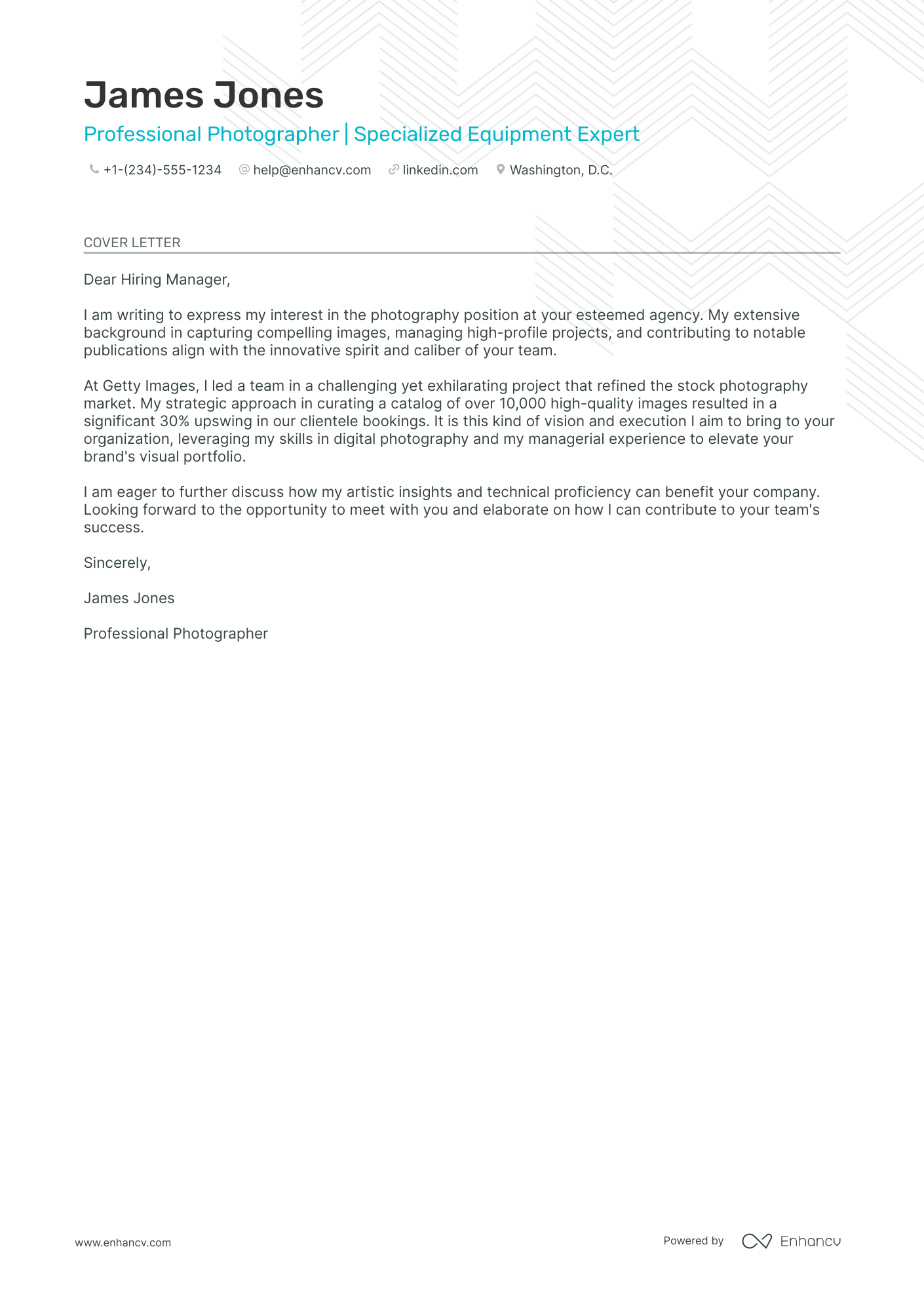Embarking on your job search, you've polished your resume and started applying, only to realize that a compelling photographer cover letter can truly set you apart. It's not just about listing skills—it's about weaving the story of your proudest professional achievement. This is your chance to showcase your unique value without falling into the trap of clichés, all while maintaining a professional tone in a concise one-page narrative. Let's guide you through crafting a standout cover letter that complements your portfolio.
- Write a photographer cover letter that helps you stand out (and get the job);
- Understand how to start and end your photographer cover letter with the appropriate greeting;
- What to include in the body of your photographer cover letter to put your best foot forward;
- Your most important achievements - how to present them as part of your photographer cover letter.
And if you want to make your life even easier, simply drag and drop your photographer resume into Enhancv's AI cover letter generator, and it will write your cover letter for you in just a few moments.
If the photographer isn't exactly the one you're looking for we have a plethora of cover letter examples for jobs like this one:
- Photographer resume guide and example
- Background Actor cover letter example
- Writer cover letter example
- DJ cover letter example
- Theater cover letter example
- Musician cover letter example
- Artistic Director cover letter example
- Videographer cover letter example
- Technical Theatre cover letter example
- Model cover letter example
- Painter cover letter example
Drop your resume here or choose a file.
PDF & DOCX only. Max 2MB file size.
Photographer cover letter example
ZOEY WALKER
San Francisco, California
+1-(234)-555-1234
help@enhancv.com
- Aligning professional values with the company's ethos demonstrates a shared vision and commitment to similar principles, such as sustainability, which is attractive to employers looking for culturally compatible candidates.
- Quantifying achievements, like increasing online engagement by 30% or reducing preparation times by 20%, provides concrete evidence of the candidate's impact and expertise, making the achievements more tangible and credible.
- Highlighting specific experiences relevant to the job, such as directing photoshoots and visual storytelling, showcases the candidate’s hands-on skills and knowledge that will be directly beneficial in the role of a Senior Home Goods Photographer.
- Mentioning the intention to improve workflow efficiency implies a proactive attitude toward company operations, which can be particularly appealing to employers looking for individuals who will actively contribute to process improvements.
The format of your photographer cover letter: structure, fonts, margins, and more
Your photographer cover letter should include a header (with your name, position, and date); a greeting and introductory paragraph; a body and closing paragraphs; and an optional signature.
Remember that you're writing your photographer cover letter for recruiters - as the Applicant Tracker System won't scan this content.
Here are a few more tips and tricks to keep in mind when formatting your photographer cover letter:
- Use the same font in your photographer cover letter and resume. We recommend modern fonts, e.g. Lato and Rubik, to help you stand out, instead of the stereotypical Arial and Times New Roman.
- Each paragraph should have single spacing, which is already set up for you in our cover letter templates.
- Our cover letter builder follows industry standards for your photographer cover letter formatting - with a one-inch margin, surrounding your content.
- Always export your photographer cover letter in PDF to ensure the image or text quality stays the same and your writing isn't moved about.
Too busy to write your cover letter? Let our free cover letter generator handle it in just a few clicks.
The top sections on a photographer cover letter
Header: The header should include the photographer's contact information, allowing the recruiter to easily identify and reach out to the candidate.
Opening Greeting: Personalize the greeting by addressing the hiring manager or team directly, showing attention to detail and professionalism, which is crucial for a photographer establishing rapport with clients and colleagues.
Introduction: Briefly mention the photography specialization (e.g., wedding, portrait, commercial) and highlight enthusiasm for the role, as an engaging introduction sets the stage for showcasing passion and creativity.
Professional Experience and Key Achievements: Detail relevant photography experience, including notable projects and the impact of the work, as recruiters are interested in seeing how a photographer's skills have been applied and the value they bring.
Closing and Call to Action: End with a concise statement expressing the desire for an interview, and indicating readiness to provide a portfolio for further review, as it is essential for a photographer to show a proactive attitude and drive engagement through visual work.
Key qualities recruiters search for in a candidate’s cover letter
- Strong visual skills and an outstanding eye for detail: Essential for composing shots and capturing high-quality images that stand out.
- Technical proficiency with camera equipment and editing software: Necessary for the production of professional-grade photographs and efficient post-processing workflows.
- A versatile portfolio demonstrating expertise in various photography styles (e.g., portrait, landscape, editorial): Shows adaptability and proficiency across a range of subjects and assignments.
- Excellent communication and interpersonal skills: Crucial for interacting with clients, subjects, and team members to understand their vision and deliver results that meet their expectations.
- Creative flair and an artistic approach: Allows for the creation of unique and compelling imagery that can tell a story or convey emotion effectively.
- Proven ability to work under pressure and meet tight deadlines: Demonstrates reliability and the capacity to manage time well, which are qualities highly valued in fast-paced and event-driven photography assignments.
Personalizing your photographer cover letter salutation
Always aim to address the recruiter from the get-go of your photographer cover letter.
Use:
- the friendly tone (e.g. "Dear Paul" or "Dear Caroline") - if you've previously chatted up with them on social media and are on a first-name basis;
- the formal tone (e.g. "Dear Ms. Gibbs" or "Dear Ms. Swift") - if you haven't had any previous conversation with them and have discovered the name of the recruiter on LinkedIn or the company website;
- the polite tone (e.g. "Dear Hiring Manager" or "Dear HR Team") - at all costs aim to avoid the "To whom it may concern" or "Dear Sir/Madam", as both greetings are very old-school and vague.
List of salutations you can use
- Dear Hiring Manager,
- Dear [Company Name] Team,
- Dear [Hiring Manager's Name],
- Dear [Department Name] Hiring Committee,
- Dear [Mr./Ms./Dr.] [Last Name],
How to start your photographer cover letter introduction
The opening paragraph of your photographer cover letter can seem like a real enigma.
Where do you start writing?
In your photographer cover letter introduction, focus on yourself by stating what:
- gets you motivated and excited about the role;
- you like best about the company, from culture to awards.
Write no more than two sentences, which are both authentic and show your enthusiasm for the opportunity.
What to write in the body of your photographer cover letter
Now that you've got your intro covered, here comes the heart and soul of your photographer cover letter.
It's time to write the middle or body paragraphs. This is the space where you talk about your relevant talent in terms of hard skills (or technologies) and soft (or people and communication) skills.
Keep in mind that the cover letter has a different purpose from your photographer resume.
Yes, you still have to be able to show recruiters what makes your experience unique (and applicable) to the role.
But, instead of just listing skills, aim to tell a story of your one, greatest accomplishment.
Select your achievement that:
- covers job-crucial skills;
- can be measured with tangible metrics;
- shows you in the best light.
Use the next three to six paragraphs to detail what this success has taught you, and also to sell your profile.
Closing remarks to end your photographer cover letter
Of course, you'll have to show gratitude to the recruiters, who have assessed your profile at the end of your photographer cover letter .
A "Thank you for the consideration" would work wonders, instead of the standard "Sincerely yours".
Do you want to make an even better impression?
Close off your photographer cover letter by promising how you see yourself excelling in the role and the positive impact you'd bring about.
A sentence that encourages some further action on the recruiter's end could also be a good way to close off the communication (e.g. provide your availability for an interview).
Keep this in mind when writing your zero experience photographer cover letter
Even though you may not have any professional experience, your photographer cover letter should focus on your value.
As a candidate for the particular role, what sort of skills do you bring about? Perhaps you're an apt leader and communicator, or have the ability to analyze situations from different perspectives.
Select one key achievement from your life, outside work, and narrate a story that sells your abilities in the best light.
If you really can't think of any relevant success, you could also paint the picture of how you see your professional future developing in the next five years, as part of the company.
Key takeaways
Within this Enhancv guide, we've provided you with plenty of advice and inspiration on writing your photographer cover letter:
- Always make sure your photographer cover letter is tailored to the role you're applying for to make a good impression on recruiters;
- In your photographer cover letter include a header (with your name, the role you're applying for, date, and contact details) and an introduction of up to two sentences that highlight your key accomplishment or why you'd fit the role;
- Focus your photographer cover letter body on one sole achievement through your career and all the valuable lessons, skills, and know-how you've learned (that are relevant to the role);
- Ensure your photographer cover letter closing statement isn't generic and includes either a call to action or a promise;
- If you lack professional experience, shift recruiters' focus to a relevant achievement (thanks to your academic or versatile experience) or toward your dreams and goals for professional growth.
Photographer cover letter examples
By Role





















